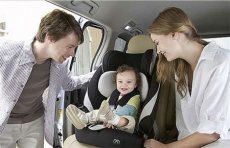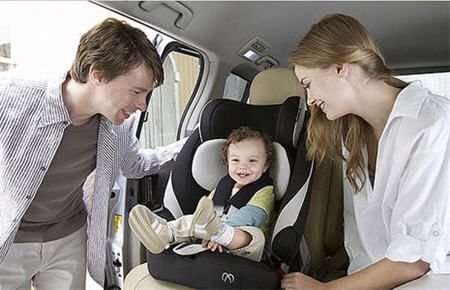Medical expert of the article
New publications
Preschooler in the car: how to ensure the safety of the child?
Last reviewed: 07.07.2025

All iLive content is medically reviewed or fact checked to ensure as much factual accuracy as possible.
We have strict sourcing guidelines and only link to reputable media sites, academic research institutions and, whenever possible, medically peer reviewed studies. Note that the numbers in parentheses ([1], [2], etc.) are clickable links to these studies.
If you feel that any of our content is inaccurate, out-of-date, or otherwise questionable, please select it and press Ctrl + Enter.

Children can never understand the danger that a car ride brings. They play around carelessly, and can even start a toy fight. Therefore, we, adults, must take care of the safety of a preschooler in a car. How to do it right?

Road accident statistics
Statistics are stubborn things, and they show that more than 15% of preschoolers who are in a car die in an accident. And more than 35% of children who have been in road accidents suffer from serious injuries. The most common cases of child deaths in cars are preschoolers under 6 years of age. Why does this happen?
Every adult, especially parents, does not want to imagine the worst. Including the fact that their child may die or hurt something in a car. Therefore, only a few people care about car safety rules: they move their child to the back seat, buy a car seat for them, help their son or daughter fasten a seat belt. But very often the life of the child depends on this, which can end at the most unexpected moment.
Have you ever seen a preschooler sitting proudly in the front seat in his mother's arms, while the traffic rules strictly require him to be in the back seat? But mom wants to be next to her husband, especially if the car is expensive and the beautiful couple with the child looks so prestigious. At the same time, the owners of expensive models do not even think that the money spent on safety equipment for their own child will pay off several dozen times. And it would be worth it.
Safety rules for preschoolers in cars
Safety rules state that children can be transported in a car only using special means to hold the baby. First of all, a preschooler must be securely fastened - this will protect him from many injuries. Moreover, the baby's body is very fragile, and in cases where an adult gets off with only scratches and abrasions, the child may have a concussion or other serious injuries.
If the child is under 3 years old, he/she should be transported in the car only in the direction of travel. The vestibular system of a child at this age is still very fragile, so transporting a child against the direction of travel can cause nausea, vomiting and headaches. In addition, if an accident occurs, children who were not riding in the direction of travel will receive much more severe injuries due to the fragility of the bones and, in particular, the fragility of the cervical spine of the child.
Carrying a preschooler in your arms is a direct violation of safety rules in a car. Because in any unforeseen situation, if the car "skids" or something happens on the road, an adult with all his weight can press on the fragile body of the baby, and then the consequences are unpredictable. It is imperative not to spare money on a car seat that is installed in the back seat.
The means for holding a preschooler in a car must be correctly selected, taking into account his weight, size, height and age. For example, if the child has not yet grown to 150 cm, then the standard seat belt will not be enough - another one, located lower, is needed. Such belts are provided on the rear seats. In addition to the seat belt, the car is supposed to have special car seats, which are designed for children of different ages.
How to choose the right child car seat?
A car seat for a preschooler should be selected according to categories. These categories are set for children from birth to 12 years. Let's get acquainted with these categories. Manufacturers of car seats for babies divide them into groups:
- a child from birth to 9 kg in weight (the seat is called a car seat)
- child from 9 kg to 15 kg (car seat)
- child from 15 kg and above – up to 12 years (car seat).
From the age of 12, a child, regardless of weight or height, can be safely seated in the back seat without a car seat. But up to 12 years, such a purchase will be reliable and useful, because the weight of each child car seat, in addition to the specified weight, can withstand an additional 10 kg.
There are nuances in choosing models: if you buy a car seat for a small child, and not a car seat for older children, this is the right choice. The fact is that a car seat allows the baby to be in the position that is more familiar to his age. In a car seat, the baby can lie down or half-sit. This model is designed for children up to 4 years old.
When the child is 4 years old and weighs between 9-15 kg, you can buy a more adult car seat. Compared to a car seat, this model will allow the child not only to semi-reclined in it, but also to sit. Children from 4 years old are very inquisitive, they are interested in looking out the window or playing in the car, so it is unlikely that you will be able to limit him only to a lying or semi-reclined position, as in a cradle.
Both car seats, which are designed for children up to 15 kg, are good because they have a special handle to easily carry this convenient design. For this reason, car seats are called baby carriers or baby carriers. They are very reliable due to reinforced side walls and special point belts. The chairs also have headrests for babies who are not yet 4 months old. And for those children who weigh up to 9 kg, the car seats also have additional pads for the shoulders. A real nest, in which it is cozy and calm!
What have manufacturers come up with for children weighing 15 kg and over? These car seats have headrests and armrests, and both parents can adjust them to make their son or daughter as comfortable as possible. If the baby is not very comfortable due to their small height, the car seats have special boosters that make it possible to lift the baby and seat him higher. And to prevent the chick from falling out, the seat belt will reliably protect it. The booster is convenient because it is removable. It can be either installed or removed - as long as the preschooler is comfortable.
What to look for when choosing a car seat for preschoolers?
Firstly, you should not rely on your own eye and choose a car seat without a child. This is a serious purchase, so parents need to make sure that the car seat is selected properly. To do this, when buying, you need to sit or lay the baby in it and make sure that he is comfortable there. Today, there is a huge selection of car seats on the market, and parents have many opportunities to choose the model that best suits their child.
"Suitable" means that the baby is not cramped in the car seat, that there is space left there taking into account his growth for the next 2-3 years. In addition, in winter the baby will be dressed warmer, so you need to choose a seat taking this into account. It should freely accommodate a preschooler in both winter and summer clothes.
When choosing a child car seat, focus on its marking. The most reliable European models are marked with the letters ECE 44/03 or ECE 44/04. This means that the model has passed tests and trials.
Don't be fooled into thinking that the more you pay for a car seat, the more reliable it is. This is far from true. Considering the information you have read above, the car seat should first of all be suitable for the child in size and age. If you have any questions about car seat models, you can use the services of a sales consultant.
There is one more nuance when choosing a car seat for a preschooler. When choosing it, you have the right to ask the seller for a certificate, which should indicate that the car seat has passed a crash test at a vehicle speed of at least 50 km per hour.
So, simple ways to stay safe on the road will help protect your preschooler in the car. 90% of his life and health are in the hands of loving parents.

